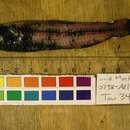Diagnostic Description
provided by Fishbase
Branchiostegal rays: 9-10 (Ref. 31442).
Morphology
provided by Fishbase
Dorsal spines (total): 0; Dorsal soft rays (total): 14 - 16; Analspines: 0; Analsoft rays: 13 - 14; Vertebrae: 35 - 38
Biology
provided by Fishbase
Epipelagic to mesopelagic (Ref. 31442) at 50-600 m at night, 500-1000 m during day (Ref. 58302). Reported from depths of 100-500 m in Subarctic Pacific gyres (Ref. 51600). Oviparous, with planktonic eggs and larvae (Ref. 31442).
Comprehensive Description
provided by Smithsonian Contributions to Zoology
Lampadena urophaos
This lanternfish is known to attain 237 mm (Krefft, 1970). The maximum size in the Ocean Acre collections is 165 mm, with most specimens smaller than 50 mm. Lampadena urophaos is a subtropical species in the Atlantic (Backus et al., 1977), where it is confined to the Northern Hemisphere (Nafpaktitis et al., 1977). According to Nafpaktitis et al. (1977), the largest collections were from the northern Sargasso Sea. Catch data from this study indicate that L. urophaos is uncommon near Bermuda. This species is represented in the Ocean Acre collections by 212 specimens; 63 were caught during the paired seasional cruises, 49 of these in discrete-depth samples, of which 33 were in noncrepuscular tows (Table 23).
DEVELOPMENTAL STAGES.—Postlarvae were 5–15 mm, juveniles 17–78 mm, and the lone subadult, a male, 165 mm. Only three juveniles, 61–78 mm, could be sexed, all were females.
REPRODUCTIVE CYCLE AND SEASONAL ABUNDANCE.—The reproductive status of this species in the study area is uncertain. The lack of ripe females (or any adults) suggests that spawning may not occur in the study area, but the presence of postlarvae and 17–18 mm juveniles suggests that spawning probably occurs nearby, if not in, the study area. The horizontal distribution of L. urophaos (Nafpaktitis et al., 1977:177) also suggests that spawning occurs in the northern Sargasso Sea. The size of the largest specimen caught during the program (165 mm) indicates that the life span is at least two years and probably longer.
Abundance was always low (Table 80). It was about the same in winter and late spring and at a bare minimum in late summer.
The parent population apparently had a prolonged breeding season, probably with a peak in late spring or summer. Postlarvae were taken from June to October, with most caught from July to September. Small (17–20 mm) juveniles were taken at all seasons. In winter most of the catch was smaller than 25 mm, and in late spring most was larger than 25 mm. In late summer too few fish were taken in discrete-depth samples to provide any indication of the size frequency distribution of the population. Specimens caught in late summer with the Engel trawl range from 32 mm to 80 mm.
The absence of mature females may be due to the relatively large size at maturity. Except for the largest, all Ocean Acre specimens are smaller than a ripe female (98 mm) reported from collections taken near Hawaii (Clarke, 1973). Fish of this size can, without doubt, easily avoid the 3–m Isaccs-Kidd midwater traw].
VERTICAL DISTRIBUTION.—Daytime depth range for all three seasons combined is 601–1000 m. Only postlarvae were taken below 750 m. At night L. urophaos was taken between 100 and 250 m at each of the three seasons. In winter it also was found at 301–350 m and 551–600 m (Table 80). The day depth range is similar to that for the species near Hawaii, and nighttime depths are somewhat more extensive than in the Hawaiian population (Clarke, 1973).
- bibliographic citation
- Gibbs, Robert H., Jr. and Krueger, William H. 1987. "Biology of midwater fishes of the Bermuda Ocean Acre." Smithsonian Contributions to Zoology. 1-187. https://doi.org/10.5479/si.00810282.452
Distribution
provided by World Register of Marine Species
Recorded off British Columbia, Canada and from Chile. 41.16°N in Atlantic
North-West Atlantic Ocean species (NWARMS)
- license
- cc-by-4.0
- copyright
- WoRMS Editorial Board
Habitat
provided by World Register of Marine Species
epipelagic to mesopelagic
North-West Atlantic Ocean species (NWARMS)
- license
- cc-by-4.0
- copyright
- WoRMS Editorial Board
Habitat
provided by World Register of Marine Species
nektonic
North-West Atlantic Ocean species (NWARMS)
- license
- cc-by-4.0
- copyright
- WoRMS Editorial Board
Habitat
provided by World Register of Marine Species
Known from seamounts and knolls
Stocks, K. 2009. Seamounts Online: an online information system for seamount biology. Version 2009-1. World Wide Web electronic publication.
- license
- cc-by-4.0
- copyright
- WoRMS Editorial Board

